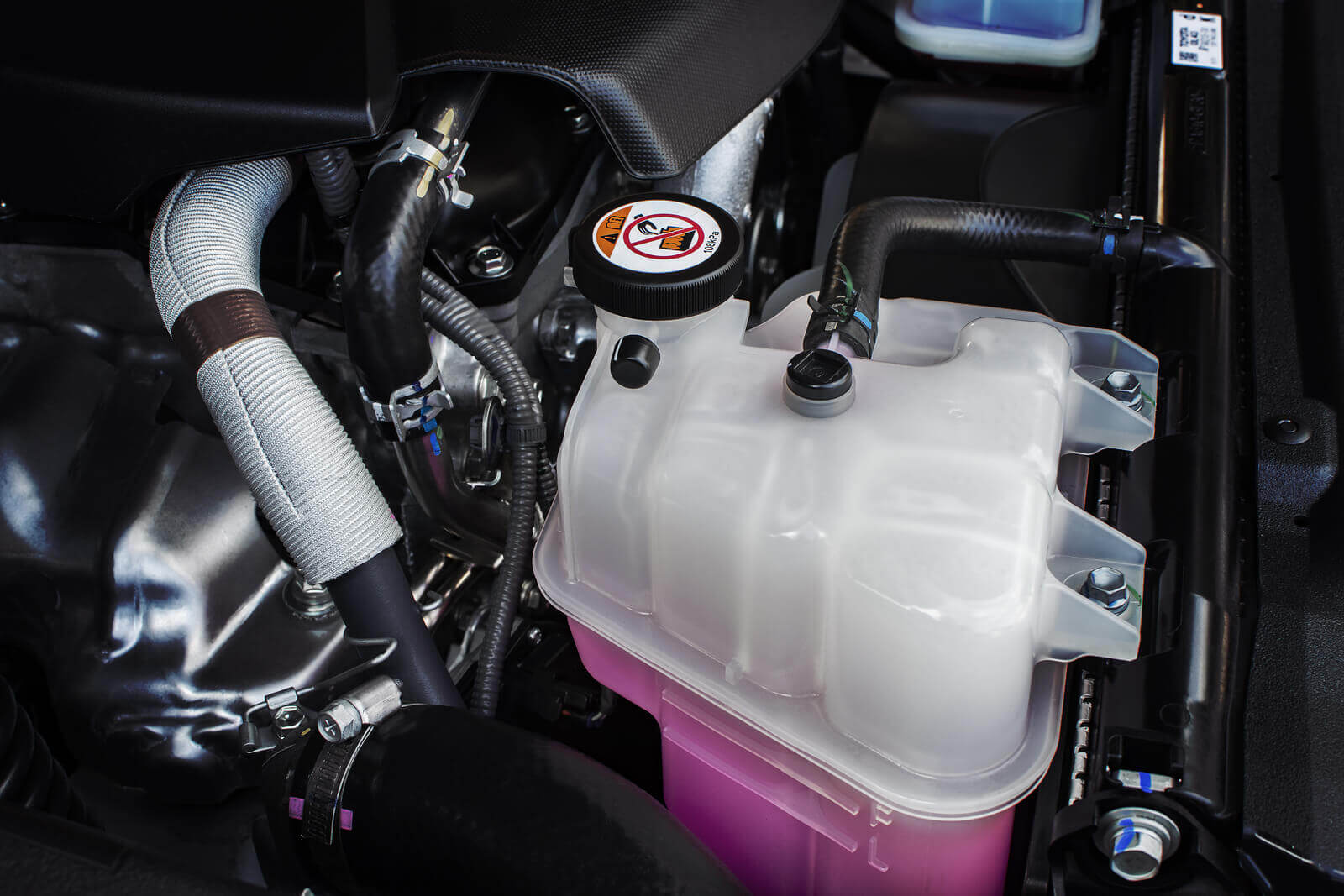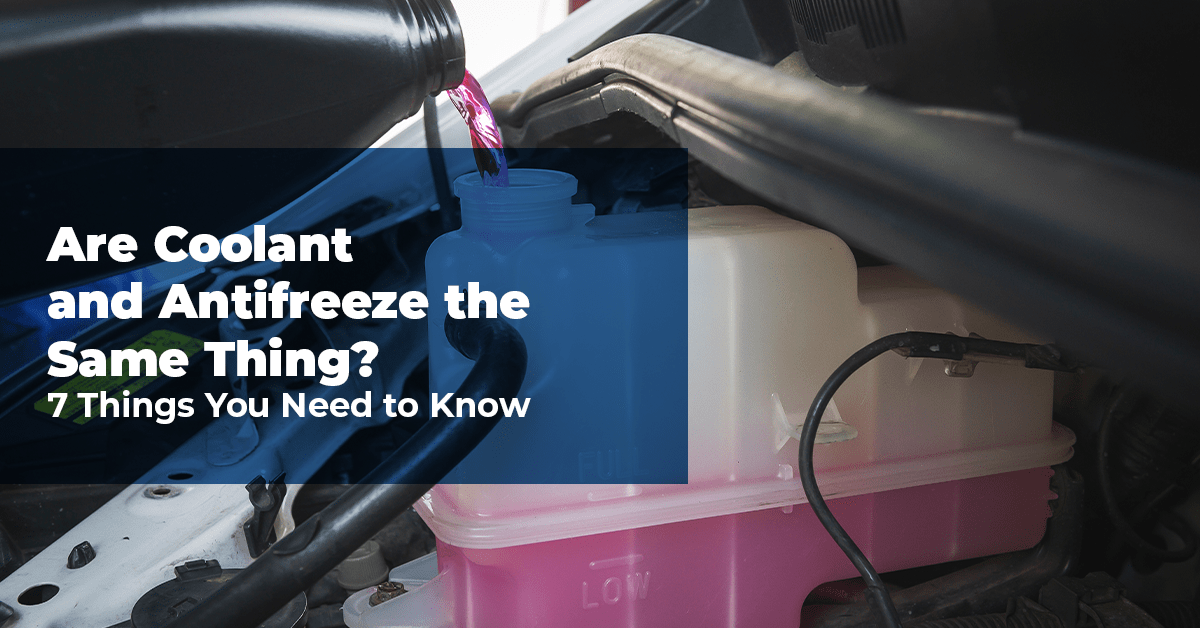The terms coolant and antifreeze are often used interchangeably, but there are several key differences between the two.
It is important that you know these differences, or you could encounter some expensive problems.
Without coolant, your car will overheat. Without antifreeze, it could freeze in cold weather - and a new radiator isn't exactly cheap!
Read on and learn the difference between antifreeze and coolant.
Page Contents
Is Coolant the Same as Antifreeze?
Coolant is a diluted form of antifreeze.
This means that they each have the same base ingredient - usually MEG (mono ethylene glycol) or MPG (mono propylene glycol) - but coolant has the addition of de-ionised water and other additives, e.g. corrosion inhibitors.
Coolant with a higher concentration of antifreeze is designed to give your engine some added protection in the winter.
It does this by lowering the freezing temperature of the coolant, preventing freezing when the engine is off.
As standard, coolant is 50% antifreeze, but you can buy coolant with a higher concentration for extreme temperatures.
In short, antifreeze and coolant are not the same thing, as antifreeze needs to be combined with de-ionised water before being used as coolant.
What Do the Different Coolant Colours Mean?
Coolant comes in various forms, which you can usually identify by the colour of the liquid.
The main three coolant colours are bright green, orange or red, and orange or yellow.
Bright Green - Inorganic Acid Technology (IAT).
IAT is often used in older cars and contains phosphates (corrosion inhibitors) and silicates.
Orange or Red - Organic Acid Technology (OAT).
OAT is found in most modern cars and provides high-temperature protection for aluminium.
Orange or Yellow - Hybrid Organic Acid Technology (HOAT).
A combination of IAT and OAT, HOAT coolant has an extended lifespan.
Coolant also comes in several other colours, including pink and blue.
You should always use the colour of coolant that your car's manufacturer recommends.
Make sure that you keep the colour of coolant consistent, as mixing the wrong types can cause major radiator and cooling system damage.
Check your vehicle handbook or seek professional advice if you're unsure about which type to use in your vehicle.
How Do You Dilute Antifreeze and Undiluted Coolant?
To make engine coolant from antifreeze, you must dilute antifreeze to avoid causing engine damage.
Check whether your coolant is already pre-mixed and, if not, add de-ionized water in a 50:50 split before adding it to your coolant tank.
De-ionised water can be found online, in hardware and automotive stores, and in certain supermarkets.
Using tap water is not recommended, as it contains too many minerals.
Pour the de-ionised water into the coolant tank.
If you are using undiluted engine coolant, be sure to dilute this in the same 50:50 ratio to avoid damaging your engine and incurring any costly repairs.
Adding antifreeze neat reduces its efficiency - as antifreeze minimises the risk of freezing in cold conditions - but alone it does not conduct heat as well as water.
Without it, your engine will overheat - so you must dilute it before you use it.
How Do You Check Your Car's Coolant Level?
A coolant check is a simple process that you can do at home.
We recommend checking this fluid regularly, just like you would with your engine oil or screenwash level.
Your coolant tank should look like this:

Most tanks are transparent, so you can see the level easily.
If it doesn't reach the 'min' line on the side, top it up with appropriately mixed coolant between the 'min' and 'max' lines.
Be sure to wait for the engine to cool before checking the coolant.
It boils as you drive, and will release scalding hot steam out of the radiator cap.
What's more, you will create a sudden change in temperature and pressure which can crack the engine block.
Check your coolant before you switch the engine on or at least 2 hours after you switch it off.
If your coolant is brown, opaque or has bits floating in it, then you need to book a coolant change immediately.
Coolant should always be translucent, no matter the colour.
Contamination reduces efficiency, meaning the longer you leave it, the greater the chance of an expensive repair bill.
Should I Worry About Low Coolant Levels?
Your car doesn't consume coolant like petrol or engine oil.
Coolant levels shouldn't drop much during normal use.
If you're constantly topping up or have to add a lot at once, then there could be a leak.
You shouldn't ignore a coolant leak for long!
A leak increases your car's chances of overheating and causing damage to the water pump, head gasket, cylinder and piston timing.
These are all expensive repairs that can set you back thousands of pounds!
In contrast, a coolant change in the UK can cost as little as £50 to £150!
Better to spend a little now than a lot later down the line.
As a general rule of thumb, you should change your coolant every 2 years or 30,000 miles.
Coolant can become less effective over time - regardless of whether the level drops - so you must change coolant at the appropriate intervals.
You can refer to your vehicle handbook to find out the intervals your car manufacturer recommends.
Note: You can only use water instead of coolant in an absolute emergency if you run out, but otherwise you should always try to keep your coolant levels adequately topped up.
How Much Is Antifreeze?
You can buy bottles of antifreeze from local automotive stores for as little as £5 to £20, depending on how much you need.
However, if you notice a problem with your coolant, topping it up won't solve the issue.
You need to drain your system and refill it with high-quality coolant and fix any leaks.
In other words, you need to book a coolant change at a professional garage near you to have any issues resolved.
Your car needs coolant to work properly all year long and to help you avoid any expensive repair bills.
If you have a leak or are using poor-quality coolant, your chances of a breakdown increase.
Be sure to book a coolant change at a local garage through BookMyGarage and have the issue resolved sooner rather than later.








No comments yet
Leave a comment